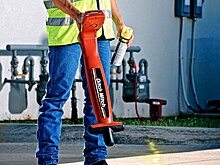Utility locating (What Is It?)

KEEP YOUR DIG AREA SAFE:
- Plan your job and Premark your dig area.
- Call 811 before you dig.
- Wait 2 business days plus the day you called.
- Perform a pre-excavation site survey.
- Respect the marks.
- Dig Safely.
- Communicate with utility owners though UNCC.
Call before you dig! We will keep your Site Safe..
Utility locating is the process of identifying and labeling public and private utility mains and svc’s which are underground. These mains may include lines for , electrical distribution, natural gas, cable television, fiber optics, telecommunications, traffic lights, street lights, storm drains, water mains, sewer mains and wastewater pipes. In some locations, major oil and gas pipelines, national defense communication lines, mass transit, rail and road tunnels also compete for space underground.
Because of the many different types of materials that go into manufacturing each of these different types of underground lines, different detection and locating methods must be used. For metal pipes and cables, this is often done with electromagnetic equipment consisting of a transmitter and a receiver. For other types of pipe, such as plastic or concrete, induction locating or ground-penetrating-radar must be used.
Locating by these means is necessary because maps often are inaccurate or not up to date and need to ensure the proper location to avoid damages. In older cities, it is especially a problem since maps may be very inaccurate, or may be missing entirely.
“Call before you dig” Colorado 8-1-1, and One call of Wyoming are services that allow construction workers to contact utility companies, who will then denote where underground utilities are located via color-coding those locations. As required by law and assigned by the U.S. Federal Communication Commission (FCC), the 8-1-1 telephone number will soon be used for this purpose across the United States.
Failure to call such a number ahead of time may result in a fine or even a criminal charge against the person or company, particularly if such negligence causes a major utility outage or serious injury, or explosion and or an evacuation due to a gas leak. Hitting a water main may also trigger a boil water advisory and local flooding.
A few utilities are permanently marked with fiberglass markers or with short posts or bollards, mainly for lines carrying petroleum products,high pressure gas lines and fiber optic lines.
Color-coding
Utility color codes are used for identifying existing underground utilities in construction areas with the intent of protecting them from damage during excavation.
Public utility systems are often run underground; some by the very nature of their function, others for convenience or aesthetics. Before digging, local governments often require that the underground systems’ locations be denoted and approved, if it is to be in the public right of way.
Colored locate lines and/or flags are used to mark the location and denote the type of underground utility. A special type of marking paint, which works when the can is upside-down, is used to mark underground buried lines. On flags, a logo often identifies the company or utility owner which the lines belong to, or a contract company which has been contracted to locate for the utility owner.
The American Public Works Association (APWA) Uniform Color Codes for temporary marking of underground utilities are listed below:
| Red | electric power lines, cables, conduit, and lighting cables |
| Orange | telecommunications, alarm or signal lines, cables, or conduit |
| Yellow | natural gas, oil, steam, petroleum, or other gaseous or flamable material |
| Green | sewers and drain lines |
| Blue | drinking water |
| Purple | reclamed water, irrigation, and slurry lines |
| Pink | temporary survey markings, unknown/unidentified facilities |
| White | proposed excavation limits or route |





Leave a Reply